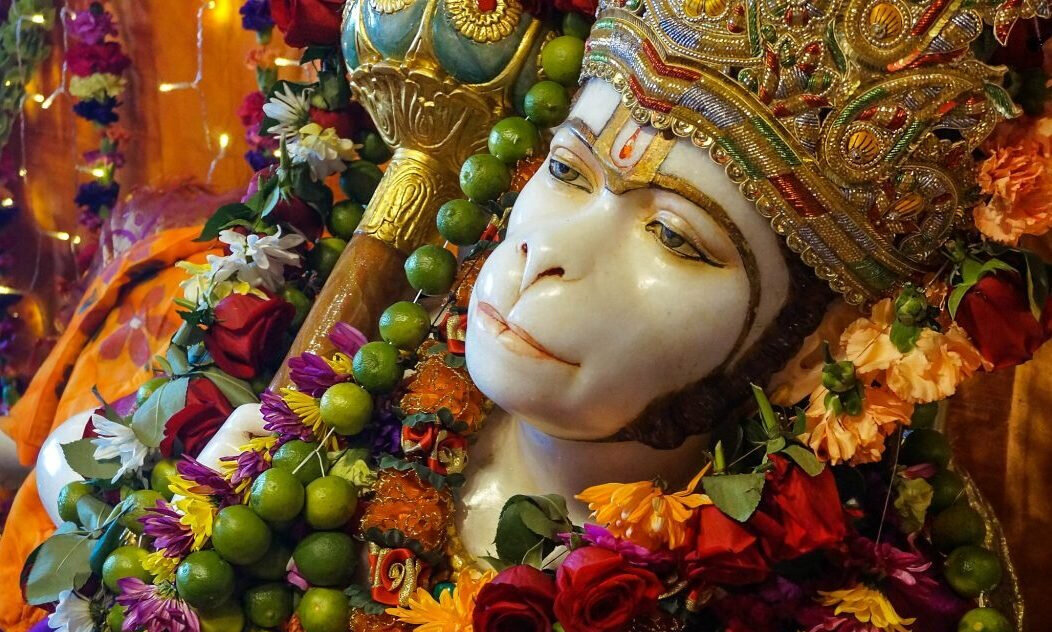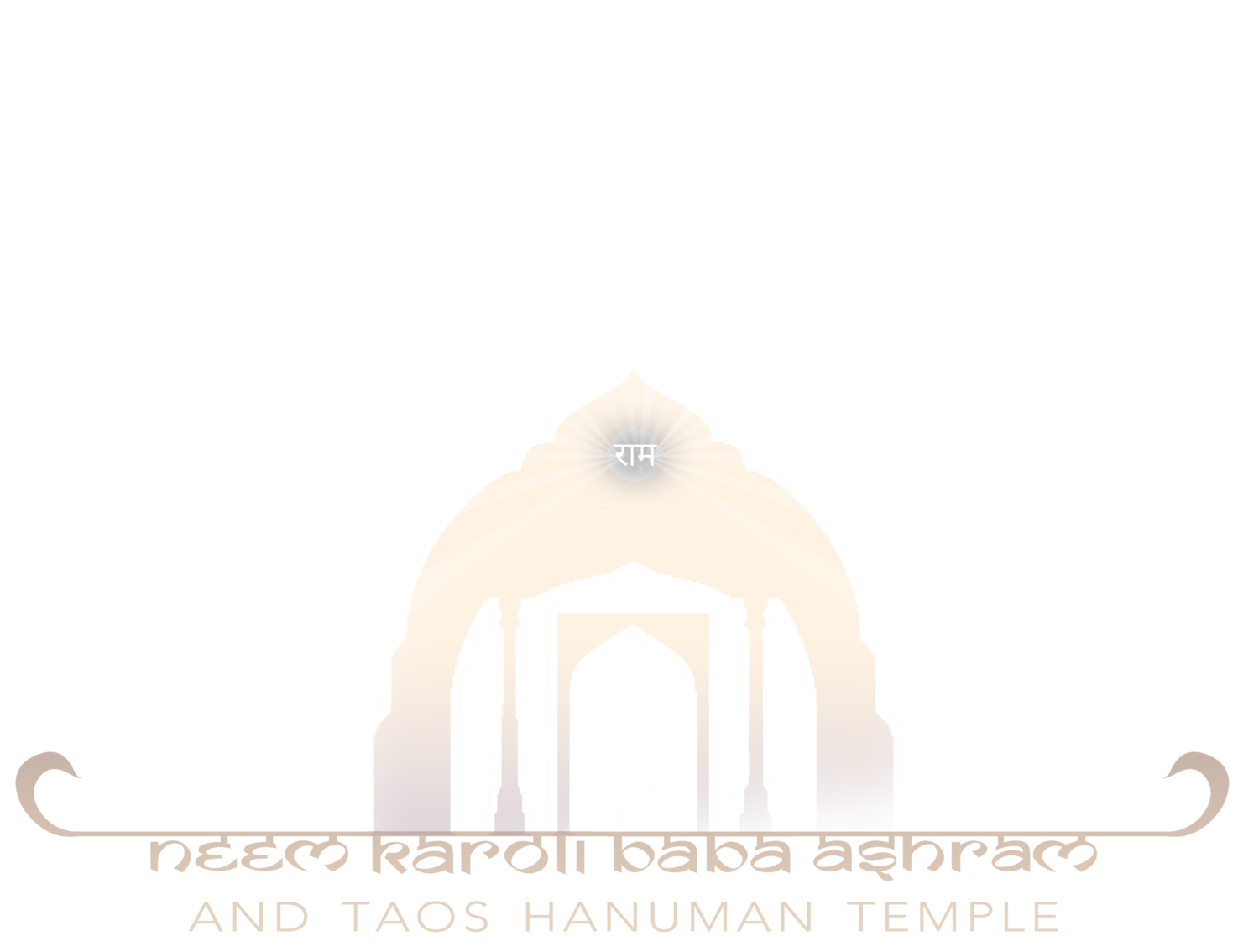
Jai Shri Hanuman-Ji!
Grant me strength, intelligence and wisdom and remove my sorrows and shortcomings…
All of Maharaj-ji’s temples and ashrams in India have close associations with Hanuman. A devotee painted an image of a flying Hanuman from a dream, and a murti, or statue, of this flying Hanuman was commissioned from a traditional family of marbl sculptors in Jaipur, India. Sri Siddhi Ma, who Maharaj-ji left to care for his ashrams, oversaw the fine details of Hanuman’s sweet expression before he journeyed to the west. Hanuman was temporarily installed at the present location and ever since, devotees have dreamed of creating a beautiful space for him. As in the Ramayana, Hanuman has brought Ram’s ring to Sita, who represents our soul and the Earth Mother. With it come tidings of her imminent release from captivity. Hanuman’s message brings the promise of love and faith, a faith that moves mountains. His presence, without doubt, will reunite Sita with Ram, our souls with the Supreme. In the Taos temple, Hanuman plays a special role in this historic transmission of devotion and wisdom from India to the West, and his mission to deliver Ram’s ring to Sita is a reality.
How The Taos Hanuman Murti Came to America
After Maharaj-ji’s Mahasamadhi (leaving his body) in 1973, His American devotees longed for a place to meet and share stories, hold bhandaras (holiday feasts), sing kirtan (devotional chants), and enjoy satsang (the community of those on the path together). In the spring of 1977, a group of thirty or forty devotees gathered in upstate New York for a bhandara. Ram Dass proposed that a murti (statue) representing Hanuman be commissioned in India, for installation in a temple in America.
Calendars in India are adorned with wonderful renderings of the Gods and Goddesses. One such calendar picture, which now hangs in the Taos ashram dharmsala, was sent to a devotee who became enchanted with the form of the blissful flying Hanuman. In it, He is depicted as flying towards Lanka in search of Sita, carrying Ram’s ring in his hand (a symbol of hope and reunion, of love in motion). This served as an inspiration for the rupa, or form, in which Hanuman would be represented. This image became the model for a large painting which was then photographed and taken to Jaipur in western India. There, the same family of sculptors who carved the murti of Hanuman in Maharaj-ji’s Vrindaban ashram began working to create a sixteen-hundred-pound murti, Ram’s ring in his hand. Now Hanuman was going to fly across the ocean to get to America!
After the carving was approved, the women elders polished the murti for days. Then the painter gave color to Hanuman’s serene and gentle face. A crate was built around Hanuman. He was taken to Bombay, where permission from Indian Customs and Antiquities’ officials to leave India was received.
Several months later, in the late spring of 1978, the murti arrived in San Francisco by cargo ship. Where would Hanuman come to rest? Satsang members took trips and held discussions. Oregon? Mount Shasta? New York City? Canada? No agreement. At that point, a devotee in New Mexico volunteered to house the murti until a permanent place could be found. Hanuman was brought on a trailer to Arroyo Seco, near Taos, where a bhandara was held to celebrate the anniversary of Maharaj-ji’s Mahasamadhi and to welcome Hanuman.
Hanuman remained on the trailer for another year. He was taken to Embudo near the Rio Grande for the 1979 bhandara celebration. Then Hanuman was moved to a farm in Taos and was placed in a little adobe barn on the property. Years passed, and the little barn was renovated and improved. Slowly the farm started to serve as an ashram and a non-profit organization was set up so that the land could be purchased, parcel-by-parcel.
Today, the Neem Karoli Baba Ashram wholly owns the land. A kitchen was built, and showers and bathrooms were installed. Over the years, the ashram evolved into the present arrangement, with a Board of Directors making decisions based on input from satsang. Hundreds of devotees come each September to celebrate the Mahasamadhi of Neem Karoli Baba with a bhandara, kirtan, and satsang. All are welcome to utilize their time in seva (service), singing kirtan, prayer, or in talk about Maharaj-ji’s lilas (the dance of Grace).
Who is Hanuman, and How did he Get that Ring?
In the Ramayana, Hanuman symbolizes the sadhana shakti, or power of spiritual practice. He is also the symbol of the faith that can move mountains. He is the son of the monkey hero Kesari (lion-like resolve), and mother Anjani (beautifying collyrium—the divine ungent of pure feeling applied to the vision of the soul). God in the form of Cosmic Prana-the wind-god, Vayu (an aspect of the Cosmic Mind)-is his Divine Father. In fact, Hanuman is an emanation of Lord Shiva (Brahman, or the unchanging reality amidst and beyond the world). The emergence of faith in the heart of an aspirant is the result of the convergence all of these mystical elements.
It is believed that wherever and whenever the Ramayana is read, Hanuman (in an invisible form) is present with wistful ears adorned with mystic earrings,
craving to listen to the delightful narrative of Lord Rama’s life story again and again.
-Based on commentary by Swami Jyotirmayananda, “A Mystical Interpretation of the Hanuman Chalisa”…..
Hanuman Chalisa Verses and Full Commentary
Click here for an In-depth word for word Translation of the Hanuman Chalisa and Accompanying stories and commentary.





